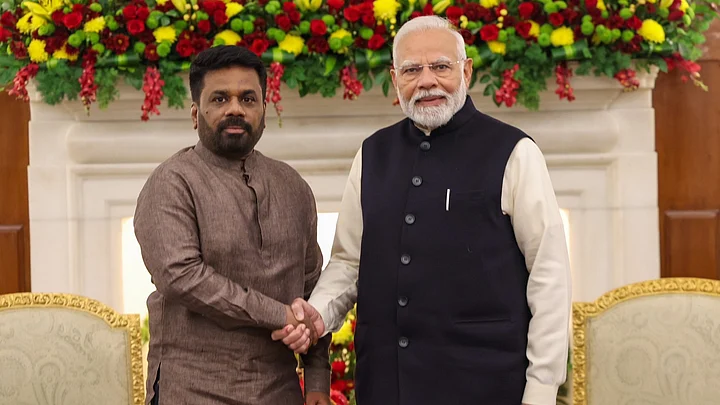The fact that the Sri Lankan President Anura Kumara Dissanayake chose India as his first overseas visit has drawn a lot of attention. Since he belongs to the Janatha Vimukthi Peramuna (JVP), a Left-leaning party, the general perception was that he would posture himself as pro-China – and thus visit Beijing first.
However, his decision to visit India underscores the fact that Colombo is trying to balance its relationship with both New Delhi and Beijing. During his visit, he was welcomed by President Droupadi Murmu and met Prime Minister Narendra Modi. He also visited Bodh Gaya to offer prayers.
The visit can be termed successful as both sides signed a number of Memorandums of Understandings (MoUs) – covering a wide range of areas. New Delhi has provided Colombo with a line of credit amounting to $5 billion, and has inculcated cooperation agreements with around 25 Sri Lankan districts.
In addition, India has also agreed to engage with digital projects in Sri Lanka, and focus on sectors like housing, fisheries, dairy and infrastructure. It will also be engaged in providing scholarships to around 200 students and training Sri Lankan civil servants. Further, India is also planning to export LNG to Sri Lanka.
Contentious Issues Avoided During Visit
However, what is interesting is that both sides steered clear of uneasy issues, as there was no mention of the 13th amendment of the Sri Lankan constitution and the future of the Adani power project.
The Sri Lankan president thanked New Delhi for its support during the Sri Lankan financial crisis, which had let to major domestic turmoil and a political crisis.
In another special gesture, the navies of Sri Lanka and India began their 2024 edition of the exercises called SLINEX on 17 December, a day after Dissanayake landed in India.
On the same day, in another diplomatic move, Sri Lanka repatriated 18 Indian fishermen who were arrested for allegedly crossing the International Maritime Boundary Line earlier in December.
However, the point that stood out is that both sides have agreed to sign a security cooperation agreement soon – and New Delhi will be providing hardware support to Colombo to strengthen its defence. Prime Minister Modi asserted,
“We are in full agreement that our security interests are interconnected. We have decided to quickly finalise the security cooperation agreement. We have also agreed to cooperate on hydrography."
This was coupled with another prominent statement made by Dissanayake regarding the geopolitical concerns of New Delhi. "I have also given an assurance to the Prime Minister of India that we will not allow our land to be used in any way in a manner that is detrimental to the interest of India. The cooperation with India will certainly flourish and I want to reassure our continued support for India," he said.
Marking a Difference With China
India has also reiterated that it is keen on extending help in the form of investment and grants in order to avoid adding to the Sri Lankan debt burden. This represents a clear indication to set aside India's approach towards Sri Lanka compared to China’s. The reassertion of security cooperation and statements of support for respecting territorial sovereignty clearly underscore the change in the diplomatic discourse in South Asia.
Sri Lanka has been struggling under the debt trap challenges posed by Chinese investments. The major outcome of this being the leasing of the Hambantota Port for 99 years to China in 2017 which was a defining moment for the geopolitics of South Asia. The leasing of the port underscored the culmination of Chinese aspirations and its alleged debt trap, while underscoring India’s warning with respect to the Belt and Road Initiative (BRI).
Since then, the port, which is almost fully controlled by Beijing, has become the point of alleged spying and reconnaissance against India. A number of Chinese spy vessels have continued to dock there and have raised challenges for the Indian Navy – which had become a thorn in India-Sri Lanka relations.
However, the situation in South Asia and India’s relations with its neighbours still seem to be too strained. One cannot ignore the fact that the Nepalese PM KP Sharma Oli just concluded his first visit to China, while the same was undertaken by Maldives PM Mohamed Muizzu too. The relations between India and Pakistan continue to be challenging while the domestic turmoil in Bangladesh has birthed a new issue for New Delhi.
Given such a backdrop, and the prominent inroads made by Beijing in South Asia, Dissanayake choosing India as his first foreign visit is a positive development for New Delhi.
The reality that Pakistan, Sri Lanka, Nepal, and the Maldives owe a huge amount of money to China, which has in turn challenged the sovereignty of the smaller nations and aggravated India’s security concerns, cannot be changed. But one should welcome the positive direction which the Sri Lankan president's visit provides.
At the same time, one cannot shake the centrality of China for Sri Lanka. The Sri Lankan foreign ministry also announced that the president will be visiting China next month, arguing that he wants to maintain “win-win” ties with all countries. This definitely underscores that China is crucial for the development and economic growth of Sri Lanka.
However, the first visit to New Delhi does provide some credibility to the argument that Colombo wants to maintain its civilisational and cultural relations with India and understands the centrality of India in the South Asian region.
(Dr Gunjan Singh is an Associate Professor at Jindal Law School, OP Jindal Global University. This is an opinion piece and the views expressed are the author’s own. The Quint neither endorses nor is responsible for them.)
